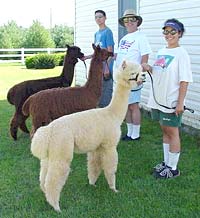|
|
Halter Training
Preparation for halter training
begins at an early age. Early handling of crias
for daily weighing, and health checks begins
building trust with the alpaca. Building trust,
however, does not mean constantly hugging, or
touching your crias. They must not be imprinted
on humans, i.e. first and foremost they need
to realize that they are alpacas and part of
the herd, not pets. Alpacas that are overly
imprinted on people are more likely to spit
at humans, and males are more likely to engage
in aggressive behavior as they would toward
other male alpaca competitors.
With that said, we usually
begin actual on-halter training after 3 months
of age, and before weaning. Initial sessions
must be short and will only get the cria used
to having a halter on their face, and not being
able to walk away from you. Crias will jump,
refuse to move their heads, and often flop on
the ground and play dead. Keep early training
sessions to 10-15 minutes. As the training progresses,
take the cria away from the other alpacas so
the cria can concentrate on the task at hand.
We find that removing them from their familiar
surroundings enables the animal to focus more
on what they are being taught.
At first, any forward movement
is helpful even if the alpaca is choosing the
direction. Then work on steering them the way
you want them to go, starting and stopping at
your signal, holding their heads and bodies
the way that they should. Keep in mind the signals
that you are giving to the learning alpaca.
Constant pulling on the lead is likely to have
an alpaca that is leaning away from you the
entire time or turning towards you to try and
release the pressure. If the alpaca is doing
the right thing, you need to ease up on the
lead.
 |
 |
Your halter training should
have two goals in mind: basic handling, which
includes moving the animal around the field,
to the barn, or into a trailer, and showing.
Showing an alpaca is an art form. Untrained
alpacas (or their handlers depending on your
point of view) lose points in the show ring
in nearly every class at every show. Judges
can not determine the confirmation of your animal
if they will not walk freely without a struggle.
Likewise they cannot judge your alpaca’s
fleece, if they won’t stand still long
enough for the judge to get their hands in the
fleece. If you are unfamiliar with how alpacas
are shown, attend a show and observe. While
training your alpacas, get them to the stage
where you can put them through a mock show complete
with someone acting as a judge, checking their
confirmation, fleece and teeth, etc.
With the proper patience and
training spread out over daily sessions for
as long as it takes, you will have an alpaca
that will be easily shown, moved around the
farm and transported. A well-trained alpaca
will follow you around on a loose lead and will
be more valuable.
|